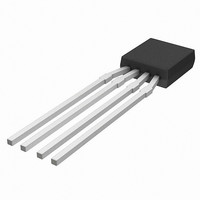KMZ10C,112 NXP Semiconductors, KMZ10C,112 Datasheet - Page 15

KMZ10C,112
Manufacturer Part Number
KMZ10C,112
Description
IC MAGNETIC FIELD SENSOR SOT195
Manufacturer
NXP Semiconductors
Type
Special Purposer
Specifications of KMZ10C,112
Sensing Range
2mV/V
Voltage - Supply
5 V ~ 10 V
Output Type
Analog
Operating Temperature
-40°C ~ 150°C
Package / Case
SOT-195
Mounting Style
SMD/SMT
Maximum Operating Temperature
+ 150 C
Minimum Operating Temperature
- 40 C
Supply Voltage (min)
5 V
Supply Voltage (max)
10 V
Operating Temperature (min)
-40C
Operating Supply Voltage (typ)
5V
Lead Free Status / RoHS Status
Lead free / RoHS Compliant
Current - Supply
-
Current - Output (max)
-
Features
-
Lead Free Status / Rohs Status
Lead free / RoHS Compliant
Other names
933698480112
KMZ10C T/R
KMZ10C T/R
KMZ10C T/R
KMZ10C T/R
Philips Semiconductors
WEAK FIELD MEASUREMENTS
Contents:
Principles of weak field sensing
Measurement of weak magnetic fields such as the earth’s
geomagnetic field (which has a typical strength of between
approximately 30 A/m and 50 A/m), or fields resulting from
very small currents, requires a sensor with very high
sensitivity. With their inherent high sensitivity,
magnetoresistive sensors are extremely well suited to
sensing very small fields.
Philips’ magnetoresistive sensors are by nature bi-stable
(refer to Appendix 2). ‘Standard’ techniques used to
stabilize such sensors, including the application of a strong
field in the x-direction (H
magnet, are unsuitable as they reduce the sensor’s
sensitivity to fields in the measurement, or y-direction (H
(Refer to Appendix 2, Fig. A2.2).
To avoid this loss in sensitivity, magnetoresistive sensors
can instead be stabilized by applying brief, strong
non-permanent field pulses of very short duration (a few
simply winding a coil around the sensor, has the same
stabilizing effect as a permanent magnet, but as it is only
present for a very short duration, after the pulse there is no
loss of sensitivity. Modern magnetoresistive sensors
specifically designed for weak field applications
incorporate this coil on the silicon.
However, when measuring weak fields, second order
effects such as sensor offset and temperature effects can
greatly reduce both the sensitivity and accuracy of MR
sensors. Compensation techniques are required to
suppress these effects.
O
Despite electrical trimming, MR sensors may have a
maximum offset voltage of 1.5 mV/V. In addition to this
static offset, an offset drift due to temperature variations of
about 6 ( V/V)K
ambient temperature up to 100 C, the resulting offset can
be of the order of 2 mV/V.
1998 Jun 12
s). This magnetic field, which can be easily generated by
FFSET COMPENSATION BY
Principles of weak field sensing
Philips sensors for weak field measurement
Application examples
Test modules.
Magnetic field sensors
1
can be expected and assuming an
x
) from a permanent stabilization
‘
FLIPPING
’
y
).
15
Taking these factors into account, with no external field a
sensor with a typical sensitivity of 15 mV/V (kA/m)
have an offset equivalent to a field of 130 A/m, which is
itself about four times the strength of a typical weak field
such as the earth’s geomagnetic field. Clearly, measures
to compensate for the sensor offset value have to be
implemented in weak field applications.
A technique called ‘flipping’ (patented by Philips) can be
used to control the sensor. Comparable to the ‘chopping’
technique used in the amplification of small electrical
signals, it not only stabilizes the sensor but also eliminates
the described offset effects.
When the bi-stable sensor is placed in a controlled,
reversible external magnetic field, the polarity of the
premagnetization (M
or flipped between the two output characteristics (see
Fig.17).
This reversible external magnetic field can be easily
achieved with a coil wound around the sensor, consisting
of current carrying wires, as described above. Depending
on the direction of current pulses through this coil, positive
and negative flipping fields in the x-direction (+H
are generated (see Fig.18). Although in principle the
flipping frequency need not be an exact figure, design
hints are given in the Section “Typical drive circuit”.
Fig.17 Butterfly curve including offset.
x
) of the sensor strips can be switched
V O
offset
M x
M x
H y
General
MLC764
x
and H
1
can
x
)














